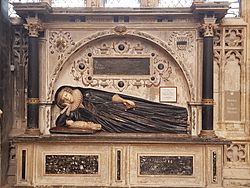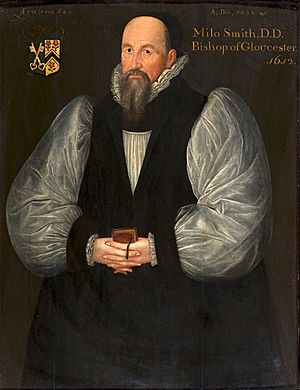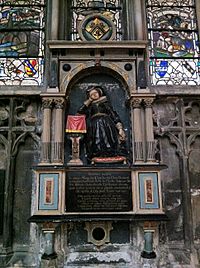Miles Smith (bishop) facts for kids
Miles Smith (born in 1554 in Hereford, died in 1624 in Gloucester) was an important clergyman in the Church of England. He was known as a very smart theologian, scholar, and someone who loved books. After earning his Doctor of Divinity degree, he became the Bishop of Gloucester from 1612 to 1624. Even though he might not have been the best at managing things, his deep knowledge was super important for translating and creating the famous King James Bible.
Contents
His Life Story
Miles Smith was born in Hereford. His father was a fletcher, which means he made arrows. Miles went to Hereford School. He had a brother named Richard and a sister named Anne. In 1568, he went to Corpus Christi College, Oxford, and then to Brasenose College, Oxford. He earned his first degree in 1572 or 1573 and his Master's degree in 1576.
He continued his studies at the University of Oxford, getting his Bachelor of Divinity in 1584 or 1585. He also earned this degree at the University of Cambridge in 1586. He became a vicar (a type of priest) in Bosbury in 1584. Later, he became a rector (another type of priest) in Hampton Bishop and Ledbury in 1587.
Miles Smith became a canon at Hereford Cathedral and received his Doctor of Divinity degree in 1594. People said he became an "incomparable theologian." He also became a chaplain at Christ Church, Oxford. In 1595, he became a canon of Exeter. He was a rector in Hartlebury from 1598 to 1624 and in Upton-on-Severn in 1604. In 1610, he became one of the first members of Chelsea College.
In 1612, he was chosen to be the Bishop of Gloucester. He passed away in 1624 when he was 70 years old and was buried in the cathedral there. He was known for his strong Calvinist beliefs and for collecting many books. In 1592, he wrote an introduction for Bishop Babington's book about the Bible.
Working on the King James Bible
Miles Smith was a key person in translating the King James Version of the Bible. He worked with the "First Oxford Company," which was in charge of translating the later books of the Old Testament. After the translation was done, he and Thomas Bilson, who was the Bishop of Winchester, did the final check of the entire text before it went to the printer.
Thomas Bilson wrote the special letter called the "Dedicatory Epistle" at the beginning of the Bible. Miles Smith wrote the "Preface," titled "The Translators to the Reader." Both of these important writings are found at the start of the King James Bible.
Disagreement with William Laud
Many people believe that Miles Smith became Bishop of Gloucester in 1612 because of his hard work on the Bible translation. However, he was also known for supporting the Calvinist group. He often sided with lecturers in his area, even when they disagreed with the local church ministers.
King James appointed William Laud to be the Dean of Gloucester. The King felt the church in Gloucester was not well-managed and wanted Laud to fix things. Bishop Smith had placed the Communion table in the middle of the church's main area. But in 1616, Laud moved it to the very front, where the main altar usually stood. Laud also told everyone to bow low towards it.
Bishop Smith strongly disagreed with this change. It's said that he declared he would never enter the church again until the table was moved back. His chaplain wrote a letter protesting the change. He worried that moving the table would encourage practices similar to those of the Roman Catholic Church, which many at the time feared. This letter caused a big stir among the people in the city who were against these changes. Eventually, Laud and Smith worked together to calm the situation, which the King liked.
His Death and Burial
Bishop Smith passed away in November 1624, with his children by his side. His will, which is like a last testament, was written in March 1623 and finalized in October 1624. He was buried on November 9 in the Lady Chapel of Gloucester Cathedral. His grave was marked by a white stone with no words, only his family crest combined with the crest of the Gloucester church.
Miles Smith left his amazing collection of Hebrew and Arabic books to the Hereford Cathedral library. These books were meant to be used by scholars studying the Bible. His will mentioned many important texts, including:
- The Venice Bible, which included special translations and rabbinic writings.
- Works by Maimonides, a famous Jewish scholar.
- Books by David Kimhi, including his Hebrew grammar and dictionary.
- A book by Elia Levita called Meturgeman.
- A special Hebrew Bible in four volumes.
- An Arabic Dictionary by Stephanus print Raphelengius.
- An Arabic Grammar by Erpenius.
- An Arabic New Testament and the first five books of Moses (the Pentateuch).
- An Arabic Lexicon Talmudicum.
- A Hebrew Concordance, which helps find words in the Bible.
His Sermons
After Bishop Smith died, his funeral sermon was given by Thomas Prior, a prebendary of Gloucester. This sermon was printed in 1632. Along with it, a collection of fifteen of Smith's sermons was published. These sermons also included more information about his life. It was later shown that some of these sermons were from his time as bishop, because they used parts of the King James Bible, which was translated in 1611.
His Family

Miles Smith was married twice. His first wife was Mary Hawkins from Cardiff, and she was the mother of all his children. His second wife was Elizabeth Ligon, but they did not have any children together. His will did not mention either wife by name.
He had four sons:
- Gervase Smith, who helped manage his father's affairs after he died.
- Miles Smith, who also helped manage his father's affairs.
- Robert Smith.
- Edward Smith.
He had four daughters:
- Margery Smith, who married James Clent. She died in 1623.
- Elizabeth Smith, who married John Williams. She died in 1622.
- Margaret Smith, who married Edmund Morgan. She was alive in 1624.
- Katherine Smith, who married William Sutton.
There are beautiful monuments with statues of his daughters Elizabeth and Margery in Gloucester Cathedral. Both of them sadly passed away during childbirth.
Images for kids






